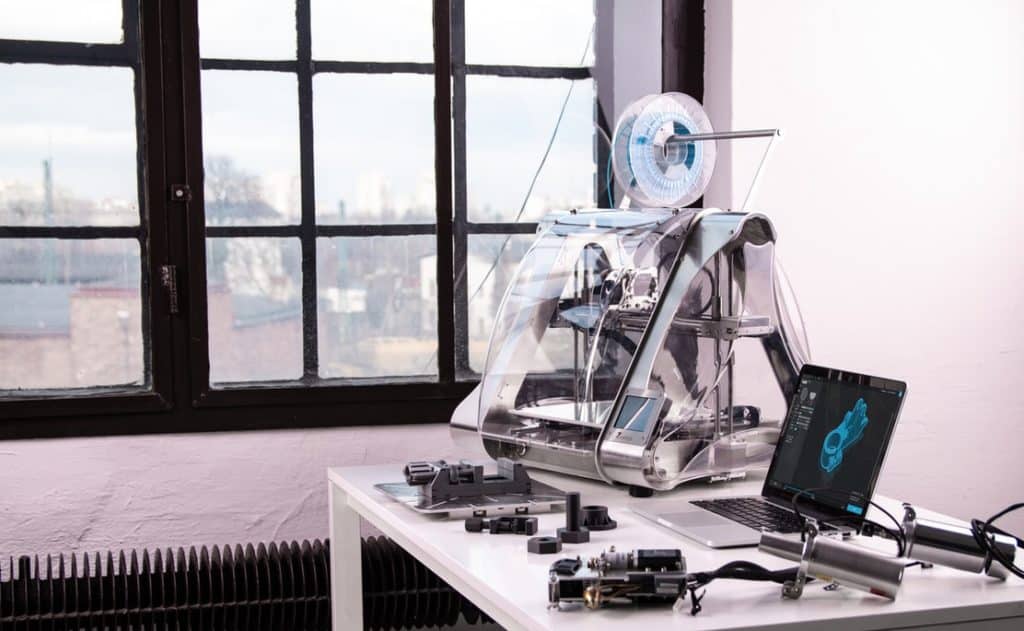Artificial intelligence (AI) is revolutionizing electronic product design and manufacturing, streamlining processes to enhance speed, intelligence, and cost efficiency. While AI-driven tools were once reserved for corporations with extensive R&D budgets, advancements in software, cloud computing, and automation have made these capabilities more accessible to manufacturers across the industry—whether startups, mid-sized producers, or global enterprises.
For businesses developing electronic products, AI enables rapid prototyping, predictive quality control, and optimized supply chain management. Instead of relying on lengthy manual design processes, AI-assisted electronic design tools can streamline circuit layouts, optimize printed circuit boards (PCBs), and refine mechanical design aspects in record time. AI-powered inventory and logistics solutions can also help prevent costly stockouts, reduce material waste, and improve production efficiency.
This guide will explore practical applications of AI in electronics manufacturing, including AI-driven prototyping, supply chain automation, and smart inventory management. More importantly, it will provide cost-effective strategies for businesses to implement AI without requiring a massive in-house engineering team or extensive technical expertise.
Key Takeaways
- AI is democratizing electronics product design and manufacturing, making powerful tools accessible to businesses for faster prototyping and improved quality control.
- AI enhances supply chain management by accurately forecasting demand and optimizing inventory levels, helping businesses avoid costly stockouts and waste.
- Affordable cloud-based AI solutions allow businesses to adopt advanced technology without major capital investments, enabling them to compete with larger companies effectively.
AI in Rapid Prototyping & Product Design
Prototyping is crucial in electronics product design, and AI is making it faster and more cost-effective. AI-powered generative design software can automatically optimize circuit layouts, component placements, and material choices, dramatically reducing manual engineering time. This allows your engineering team to focus on perfecting your product by freeing up time that might’ve been spent on repetitive tasks.
AI-assisted modeling enables businesses to run virtual simulations on durability, electrical efficiency, and heat dissipation before creating physical prototypes. This approach cuts costs, speeds up iterations, and ensures the final product meets the required standards before production.
The result? A streamlined electronic design process that brings high-quality electronic hardware and electronic systems, along with mechanical design, and electronic components devices to market more swiftly.

Enhancing Product Development with AI
The integration of AI into product development processes ensures that every stage, from concept to completion, is more efficient. AI-driven image analysis can enhance quality control by inspecting circuit board connections in real time, reducing defective units before final assembly. This technology is particularly valuable for manufacturers producing high-precision electronics, where early defect detection can prevent costly errors.
AI-powered real-time monitoring systems ensure consistent soldering and component alignment, crucial for the reliability of electronic products. Automating these quality checks with AI helps maintain high standards throughout production, allowing engineers to focus on innovation rather than troubleshooting.
Boosting Supply Chain Efficiency with AI-Driven Inventory Insights
AI is also significantly impacting supply chain optimization by analyzing historical sales data, seasonal trends, and supply chain risks to predict demand accurately. This capability reduces overproduction and waste, ensuring inventory levels are aligned with market demand.
Machine learning algorithms can dynamically adjust inventory levels, reducing the risk of overstocking or running out of key products. Your engineering team can rely on AI to manage inventory more effectively, ensuring smooth production without unexpected interruptions.
AI-Powered Procurement & Logistics
AI-powered procurement systems are transforming how businesses manage their supply chains. These systems evaluate supplier reliability, pricing fluctuations, and delivery times, helping businesses make data-driven purchasing decisions. This leads to more reliable sourcing of raw materials and components required for production.
Automated tracking tools provide real-time insights into shipments, raw material availability, and logistics bottlenecks. You can proactively address any issues in the supply chain, ensuring uninterrupted and efficient production.
How AI Helps Companies Optimize Inventory
AI-powered demand forecasting helps predict which product variations will sell best. By accurately aligning inventory with demand, companies can avoid excess stock while ensuring popular products remain available—keeping cash flow healthy and reducing waste.
AI-driven logistics tracking also enhances supply chain efficiency by identifying potential disruptions early. Businesses can adjust shipments in real-time, minimizing delays and keeping production schedules on track. This not only streamlines operations but also improves customer satisfaction by ensuring timely deliveries.

AI and Affordable Adoption
Cost has long been a barrier to AI adoption for small and medium-sized businesses, but recent advancements have made AI tools more accessible than ever. One major factor is the rise of Software as a Service (SaaS) platforms, which allow businesses to use AI-powered solutions on a subscription basis rather than making large upfront investments in software or infrastructure. This pay-as-you-go model enables companies to scale AI adoption gradually, making advanced capabilities available without straining budgets.
Another advantage of SaaS-based AI tools is their ease of deployment. Many modern AI solutions are designed to integrate with existing inventory management, design, and analytics software, reducing the need for extensive system overhauls. While some customization or training may be necessary, businesses can often adopt AI without completely restructuring their operations. This flexibility makes AI a more viable option for companies looking to improve efficiency while keeping disruption to a minimum.
Leveraging AI Without an In-House Team
Businesses don’t need a dedicated AI team to take advantage of these technologies. By working with AI-powered service providers, businesses can access tools for supply chain management, predictive analytics, and automated quality control without developing custom solutions in-house. Outsourcing AI expertise—whether through specialized vendors, consulting firms, or pre-built SaaS platforms—frees up room for them to focus on other core business functions.

Cloud-based AI solutions also play a key role in making adoption easier. Many platforms now feature user-friendly dashboards and automation tools that don’t require deep technical knowledge, making it possible for small teams to incorporate AI into daily operations with minimal training.
Strategic Approaches to Leveraging AI
Successfully integrating AI into operations isn’t about adopting every available tool at once—it’s about focusing on high-impact applications that align with business goals. AI can streamline operations, improve decision-making, and reduce costs, but a thoughtful approach ensures these benefits are sustainable. Rather than making drastic changes upfront, organizations should take a phased approach, beginning with practical, low-risk implementations before expanding into more advanced applications.

Short-Term AI Strategies: Quick Wins for Companies
AI-powered demand forecasting helps businesses optimize stock control by predicting demand fluctuations, reducing excess inventory, and minimizing stockouts. These capabilities are particularly valuable in industries managing electronic components, raw materials, and production timelines, where even small inefficiencies in inventory can lead to costly disruptions.
Another short-term strategy involves automating quality control and defect detection. AI-driven inspection systems can analyze thousands of units per minute, spotting inconsistencies in electronic hardware, PCB layouts, or mechanical design that might be missed by human inspectors. This not only reduces waste but also enhances product reliability before reaching the market. Additionally, companies can leverage AI-powered analytics tools to assess market trends, identify inefficiencies, and refine product development strategies based on real-world data. These applications don’t require overhauling infrastructure but provide businesses with faster insights, better decision-making, and immediate cost savings.
Long-Term AI Strategies: Scaling for Growth and Innovation
Once companies establish a foundation with AI, they can expand its use into more advanced applications that drive innovation and competitiveness. Over time, AI can become a core component of product design and development, particularly in fields like electronics manufacturing. AI-assisted generative design can help engineers refine electronic product layouts, optimize PCB design, and test prototypes before physical production begins. By using AI to simulate performance, material durability, and system functionality, businesses can accelerate their product development cycles and reduce costly redesigns.
Beyond design, AI-driven supply chain automation is a powerful long-term strategy. By integrating AI into procurement and logistics, businesses can build more resilient supply chains that anticipate disruptions, adjust sourcing strategies in real-time, and optimize production workflows. This is particularly useful for companies dealing with complex electronic systems, multiple suppliers, and fluctuating raw material costs. Additionally, AI-driven customer insights can help businesses personalize marketing efforts, forecast consumer demand more accurately, and refine product offerings based on usage patterns and market trends.
The Future of AI in Electronics Manufacturing: What Comes Next?
The future of AI in electronics manufacturing is bright, with innovations making design and production even more efficient and cost-effective. Early adopters of AI will have a competitive edge in prototyping, production, and supply chain management.
Rather than viewing AI as a one-time investment, companies should treat it as an evolving toolset that grows alongside their business. By scaling AI strategically—starting with efficiency-focused implementations before expanding into product innovation and supply chain optimization—organizaitons can ensure they’re leveraging AI not just for short-term gains, but for long-term success and market leadership.

Frequently Asked Questions
How can companies afford AI-powered tools without major upfront investment?
You can easily access AI-powered tools without breaking the bank since many of them are offered as SaaS platforms, letting businesses pay only for what they use. This model helps you avoid hefty upfront investments while still benefiting from advanced technology.
How does AI streamline the electronics product design process?
AI speeds up electronics product design by optimizing circuit layouts and material selection, allowing teams to iterate quickly and minimize errors.
What role does AI play in quality control?
AI plays a crucial role in quality control by using image recognition and machine learning to spot defects and inconsistencies in real-time, ensuring better inspections. This helps maintain high standards and reduces errors in production.
Can companies implement AI without hiring AI engineers?
Companies can tap into plug-and-play AI solutions or collaborate with external AI experts, so they don’t need to hire specialized engineers, allowing them to invest in the technology without the complications of developing in-house talent.
What’s the first AI tool businesses should implement?
Most organizations benefit first from AI-driven inventory forecasting or quality control automation, as these areas provide immediate cost savings and efficiency gains. Implementing AI-powered tools for automating quality assessments can also yield immediate benefits in product reliability and reduce revision cycles.



